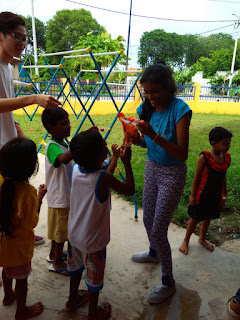Irdina...Today, my classmates and I visited the
Christ Church. We learnt fascinating facts surrounding the rich history and heritage of the church. This church was built by the Dutch when they took possession of Malacca from the Portuguese.
We noticed the well-preserved western style architectural buildings in red, long benches and silver altar vessels.
We noticed the well-preserved western style architectural buildings in red, long benches and silver altar vessels.
'A Famosa' was the first fort built by Thomas Fernandes. Visiting these historical places has made us understand the importance of conservation and restoration of historic buildings.
Suraini & Sarah...After the heritage tour, we proceeded to Harmony Street which had a Malay mosque,
Chinese temple,
and an Indian temple.
We learnt about the places of worship of the various races.
Reflection: Singapore and Malacca are different in terms of cleanliness. For example it was very difficult to find a dustbin and there was litter everywhere. The roads are very narrow and we realised that it was not safe to cross the roads in Malacca despite the presence of traffic lights. The drivers do not respect or follow the traffic rules.
Malacca's Harmony Street is very similar to our cultural attractions in Singapore. All races live in harmony and they value diversity, tolerance and respect.
Zhi Kai...Today , we visited an orphanage home. My classmates and I interacted with the young children in the home.
We entertained and engaged the young children through games and story-telling.
Reflection: It was our first time visiting an orphanage home and we realised how fortunate we are to have our families by our side. It was a memorable experience spending our time with these innocent children and we would love to visit them again next year.































































